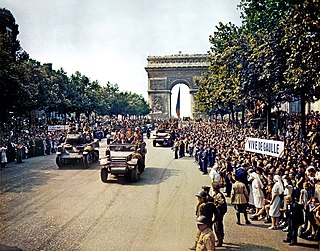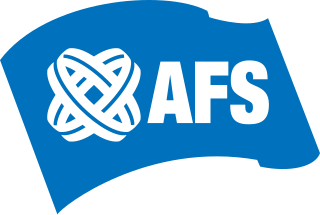
During World War II, the United States forcibly relocated and incarcerated about 120,000 people of Japanese descent in ten concentration camps operated by the War Relocation Authority (WRA), mostly in the western interior of the country. Approximately two-thirds of the detainees were United States citizens. These actions were initiated by Executive Order 9066, issued by President Franklin D. Roosevelt on February 19, 1942, following Imperial Japan's attack on Pearl Harbor, Guam, the Philippines, and Wake Island in December 1941. Before the war, about 127,000 Japanese Americans lived in the continental United States, of which about 112,000 lived on the West Coast. About 80,000 were Nisei and Sansei. The rest were Issei immigrants born in Japan, who were ineligible for citizenship. In Hawaii, where more than 150,000 Japanese Americans comprised more than one-third of the territory's population, only 1,200 to 1,800 were incarcerated.

Moïse Kisling was a Polish-born French painter. Born in Kraków, then part of Austria-Hungary, to Jewish parents, Kisling studied at the Academy of Fine Arts. He left for Paris in 1910 at the age of 19. After moving to Montmartre, Kisling became a member of the Parisian avant-garde known also as the School of Paris, and developed close professional relationships with painters Amedeo Modigliani and Jules Pascin, among others. Kisling gained recognition for portraying the female form and completed numerous nudes and portraits during his career.

The Académie Julian was a private art school for painting and sculpture founded in Paris, France, in 1867 by French painter and teacher Rodolphe Julian (1839–1907) that was active from 1868 through 1968. It remained famous for the number and quality of artists who attended during the great period of effervescence in the arts in the early twentieth century. After 1968, it integrated with ESAG Penninghen.
An émigré is a person who has emigrated, often with a connotation of political or social exile or self-exile. The word is the past participle of the French verb émigrer meaning "to emigrate".

The liberation of Paris was a military battle that took place during World War II from 19 August 1944 until the German garrison surrendered the French capital on 25 August 1944. Paris had been occupied by Nazi Germany since the signing of the Armistice of 22 June 1940, after which the Wehrmacht occupied northern and western France.
In customary international law, an enemy alien is any native, citizen, denizen or subject of any foreign nation or government with which a domestic nation or government is in conflict and who is liable to be apprehended, restrained, secured and removed. Usually, the countries are in a state of declared war.

The entirety of Germany was occupied and administered by the Allies of World War II from the Berlin Declaration on 5 June 1945 to the establishment of West Germany on 23 May 1949. Unlike occupied Japan, Germany was stripped of its sovereignty and former state: after Nazi Germany surrendered on 8 May 1945, four countries representing the Allies asserted joint authority and sovereignty through the Allied Control Council (ACC). At first, Allied-occupied Germany was defined as all territories of Germany before the 1938 Nazi annexation of Austria; the Potsdam Agreement on 2 August 1945 defined the new eastern German border by giving Poland and the Soviet Union all regions of Germany east of the Oder–Neisse line and divided the remaining "Germany as a whole" into four occupation zones, each administered by one of the Allies.

Western civilization traces its roots back to Europe and the Mediterranean. It is linked to ancient Greece, the Roman Empire and Medieval Western Christendom which emerged during the Middle Ages and experienced such transformative episodes as the development of Scholasticism, the Renaissance, the Reformation, the Enlightenment, the Industrial Revolution, the Scientific Revolution, and the development of liberal democracy. The civilizations of Classical Greece and Ancient Rome are considered seminal periods in Western history. Major cultural contributions also came from the Christianized Germanic peoples, such as the Franks, the Goths, and the Burgundians. Charlemagne founded the Carolingian Empire and he is referred to as the "Father of Europe." Contributions also emerged from pagan peoples of pre-Christian Europe, such as the Celts and Germanic pagans as well as some significant religious contributions derived from Judaism and Hellenistic Judaism stemming back to Second Temple Judea, Galilee, and the early Jewish diaspora; and some other Middle Eastern influences. Western Christianity has played a prominent role in the shaping of Western civilization, which throughout most of its history, has been nearly equivalent to Christian culture..
Ilag is an abbreviation of the German word Internierungslager. They were internment camps established by the German Army in World War II to hold Allied civilians, caught in areas that were occupied by the German Army. They included United States citizens caught in Europe by surprise when war was declared in December 1941 and citizens of the British Commonwealth caught in areas engulfed by the Blitzkrieg.

The Embassy of the United States of America in Berlin is the diplomatic mission of the United States of America in the Federal Republic of Germany. It started in 1797, with the appointment of John Quincy Adams to Berlin, the capital of Prussia. There was no permanent building for the embassy until 1930, with the purchase of the Blücher Palace. During the United States involvement in World War II, the embassy ceased operations.

Numerous internment camps and concentration camps were located in France before, during and after World War II. Beside the camps created during World War I to intern German, Austrian and Ottoman civilian prisoners, the Third Republic (1871–1940) opened various internment camps for the Spanish refugees fleeing the Spanish Civil War (1936–1939). Following the prohibition of the French Communist Party (PCF) by the government of Édouard Daladier, they were used to detain communist political prisoners. The Third Republic also interned German anti-Nazis.
Josef Nassy was a Surinamese American expatriate artist of Jewish descent. Nassy was living in Belgium when World War II began, and was one of about 2,000 civilians holding American passports who were confined in German internment camps during the war.

Crystal City Internment Camp, located near Crystal City, Texas, was a place of confinement for people of Japanese, German, and Italian descent during World War II, and has been variously described as a detention facility or a concentration camp. The camp, which was originally designed to hold 3,500 people, opened in December 1943 and was officially closed on February 11, 1948.
African Americansin France are people of African heritage or black people from the United States who are or have become residents or citizens of France. This includes students and temporary workers.

Vichy France, officially the French State, was the French rump state headed by Marshal Philippe Pétain during World War II. It was named after its seat of government, the city of Vichy. Officially independent, but with half of its territory occupied under the harsh terms of the 1940 armistice with Nazi Germany, it adopted a policy of collaboration. Though Paris was nominally its capital, the government established itself in the resort town of Vichy in the unoccupied "free zone", where it remained responsible for the civil administration of France as well as its colonies. The occupation of France by Nazi Germany at first affected only the northern and western portions of the country, but in November 1942 the Germans and Italians occupied the remainder of Metropolitan France, ending any pretence of independence by the Vichy government.

Pithiviers internment camp was a concentration camp in Vichy France, located 37 kilometres northeast of Orléans, closely associated with Beaune-la-Rolande internment camp in deporting foreign-born and some French-born Jews between 1941 and 1943 during WWII.
U.S. soldiers committed rape against French women during and after the liberation of France in the later stages of World War II. The sociologist J. Robert Lilly of Northern Kentucky University estimates that U.S. servicemen committed around 4,500 rapes in France between June 1944 and the end of the war in May 1945.

AFS Intercultural Programs is an international youth exchange organization. It consists of over 50 independent, not-for-profit organizations, each with its own network of volunteers, professionally staffed offices, volunteer board of directors and website. In 2015, 12,578 students traveled abroad on an AFS cultural exchange program, between 99 countries. The U.S.-based partner, AFS-USA, sends more than 1,100 U.S. students abroad and places international students with more than 2,300 U.S. families each year. As of 2022, more than 500,000 people have gone abroad with AFS and over 100,000 former AFS students live in the U.S.

Paris started mobilizing for war in September 1939, when Nazi Germany and the Soviet Union attacked Poland, but the war seemed far away until 10 May 1940, when the Germans attacked France and quickly defeated the French army. The French government departed Paris on 10 June, and the Germans occupied the city on 14 June. During the occupation, the French government moved to Vichy, and Paris was governed by the German military and by French officials approved by the Germans. For Parisians, the occupation was a series of frustrations, shortages and humiliations. A curfew was in effect from nine in the evening until five in the morning; at night, the city went dark. Rationing of food, tobacco, coal and clothing was imposed from September 1940. Every year the supplies grew more scarce and the prices higher. A million Parisians left the city for the provinces, where there was more food and fewer Germans. The French press and radio contained only German propaganda.

The liberation of France in the Second World War was accomplished through diplomacy, politics and the combined military efforts of the Allied Powers, Free French forces in London and Africa, as well as the French Resistance.












































